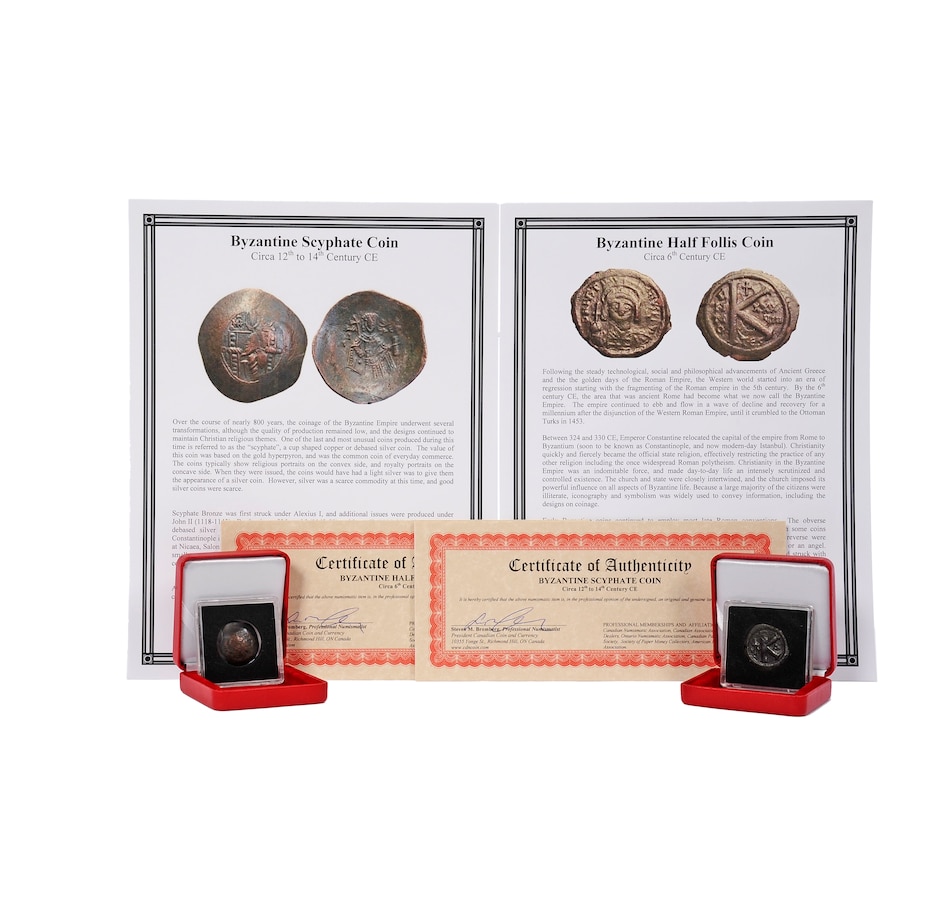Byzantine Half Follis Coin and Scyphate Coins, 491-1282 CE.
513-905
$69.95
Shipping: $6.99
or
12 Payments of $5.82
with
Product Overview
This collection includes two different Byzantine coins. The first coin as a half follis denomination dating from the late 5th Century CE, and is one of the earliest types of Byzantine coin. The second coin is a cup shaped Scyphate issued about 800 years later near the end of the Byzantine era. An information page and certificate of authenticity is included with this set of coins.
Byzantine coins were produced and circulated throughout Europe and most parts of the former Roman Empire, spanning from the time when the Roman Empire fragmented in the 5th century CE, through to the fall of Constantinople to the Ottoman Turks in 1453.
Half Follis
Early Byzantine coins continued most late Roman conventions. The obverse continues to feature the Emperor, now full face rather than in profile, although some coins featured the "Emperor of Emperors", Jesus Christ. The Roman gods on the reverse are now replaced with a Christian symbol such as the cross, or a Victory symbol or an angel. The reverse features a large letter "K", which is the Greek numeral for 20. This is the denomination, 20 nummi.
While coins of the ancient Greeks and Romans were often designed and struck with fine detail and artistry, this technology and artistic talent was largely lost through the Byzantine era. Most newly struck Byzantine coins would look much inferior to a well-worn Roman coin struck a few hundred years earlier. Attractive examples of these crudely struck coins are extremely scarce, and highly sought after by collectors.
Scyphate
These coins are sometimes described as cup-shaped, saucer-shaped or bowl-shaped. The front of the coin bear the head of the Emperor, full face rather than in profile, and on the back, usually a Christian symbol such as the cross, or a Victory or an angel.
Includes:
• Byzantine Half Follis Coin and Scyphate Coins, 491-1282 CE.
Byzantine coins were produced and circulated throughout Europe and most parts of the former Roman Empire, spanning from the time when the Roman Empire fragmented in the 5th century CE, through to the fall of Constantinople to the Ottoman Turks in 1453.
Half Follis
Early Byzantine coins continued most late Roman conventions. The obverse continues to feature the Emperor, now full face rather than in profile, although some coins featured the "Emperor of Emperors", Jesus Christ. The Roman gods on the reverse are now replaced with a Christian symbol such as the cross, or a Victory symbol or an angel. The reverse features a large letter "K", which is the Greek numeral for 20. This is the denomination, 20 nummi.
While coins of the ancient Greeks and Romans were often designed and struck with fine detail and artistry, this technology and artistic talent was largely lost through the Byzantine era. Most newly struck Byzantine coins would look much inferior to a well-worn Roman coin struck a few hundred years earlier. Attractive examples of these crudely struck coins are extremely scarce, and highly sought after by collectors.
Scyphate
These coins are sometimes described as cup-shaped, saucer-shaped or bowl-shaped. The front of the coin bear the head of the Emperor, full face rather than in profile, and on the back, usually a Christian symbol such as the cross, or a Victory or an angel.
Includes:
• Byzantine Half Follis Coin and Scyphate Coins, 491-1282 CE.
About the Brand
Learn More





